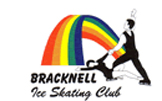Bracknell Ice Skating Club Newsletter - June 2004
Adults’ Night
Just nine skaters took part in the club’s annual competition for adults on May 26.However because five of them entered more than one class, they made up 18 entries in six free and five dance classes.
The event is arranged specially as a warm-up for those skating in the club’s Adult Open the following month and the classes are geared to their needs.
As the club’s motto is Skating For All, it was good to see less accomplished skaters competing in front of an audience.
Like the club’s younger members, there was a big difference in the quality of skating with some good efforts by some of the newer competitors as well as some polished performances by some of the more experienced skaters.
It is just a shame that so few members competed and that so few people bothered to go along to support fellow club members. In fact, just about the only people there were officials and competitors’ relatives!
Competition organiser, Sue Truby, who skated in four classes, is disappointed that so few members took part and is concerned that a whole evening of club ice should be devoted to so few skaters.
She intends introducing a spin, spiral, jump competition and possibly dance and field moves classes next time to encourage those without programmes to take part.
Results:
Free:
beginners: Pat Hurst, 1st;
Level 1: Lesley Brenikov, 1st, Gail Tudor, 2nd;
Level 2 and over: Rachel Jarvis, 1st, Nicki Torrington, 2nd, Val Toeman, 3rd;
improvisation, Level 2 and over: Rachel Jarvis, 1st; under Level 2: Ian Turner, 1st;
artistic; Level 1 and under: Ian Turner, 1st;
Dance:
compulsory: Level 2 and under (rhythm blues and Dutch waltz): Rachel Jarvis (1st, 1st) 1st, Gail Tudor (2nd, 2nd) 2nd;
open standard (Golden Skaters Waltz and foxtrot): Sue Truby (2nd, 1st) 1st, Viv Coene (1st, 2nd) 2nd;
free dance: Level 3 and under: Viv Coene, 1st, Sue Truby, 2nd;
variation dance: Level 3 and under: Sue Truby, 1st;
original dance, any standard: Gail Tudor, 1st, Sue Truby, 2nd.
Best overall skater: Rachel Jarvis.
Simon Says - Warming Up
Warming up properly before any sports activity is crucial to avoid injury, improve performance and reduce soreness after exercising. Most top skaters do not step on to the ice without about 30 minutes of off-ice work. However, many people misunderstand what is meant by a warm-up. It is not simply walking into the rink and flicking your leg back a few times, or placing it on the barrier. The really critical part - most important to prevent injury and prepare you for skating — is physical activity for long enough to increase the temperature of your body ("warm-up") and increase the blood flow to your muscles.Although in principle it is possible to warm- up on the ice by doing a few laps or certain moves in the field, you will be wasting valuable (and often expensive) ice time on something which can be done for free at the rink-side. Working on stroking is never a waste of time, but it is much easier to concentrate on proper technique and posture when you are not cold and stiff. It is also impossible to stretch your leg muscles properly with your boots on!
Finally, if you test or compete it is especially important to have an off-ice warm-up routine in order to be able to use the short on-ice warm-up more effectively. A set warm-up routine also helps you to relax, adds a sense of familiarity to a new rink and keeps those pre-performance nerves under control.
Here are some suggestions for a warm-up:
* Start by "lubricating" your joints: gently rotate your head, shoulders, elbows, wrists, and waist, bend your knees, rise up on to toes and rotate your ankles.
* Do a few minutes of jogging, or skipping. This is not just one lap of the rink! It has to be intensive and long enough for you to break into a sweat, but you should not run out of breath or tire out your muscles.
* Free skaters can also do a few single and multi-revolution jumps and dancers may run through programmes off-ice.
* Stretch all the major muscles in your body, hold for about 10 seconds but be wary of over stretching while you are still warming up.
Be aware that some stretching exercises can be harmful if they are not done correctly.
Now you are ready to boot up and step on the ice having saved 10-15 minutes of skating time and having given yourself a much better chance of skating your best. As a rule of thumb, the higher your skating level and the older you are, the more you benefit from a longer warm-up. However, even a few minutes make a big difference - you get a feeling for the ice much faster and skate with more power and better balance from the start, so you can make more efficient use of the session.
Page 1 - 2 - 3 - 4 - Click the number to go to the page
